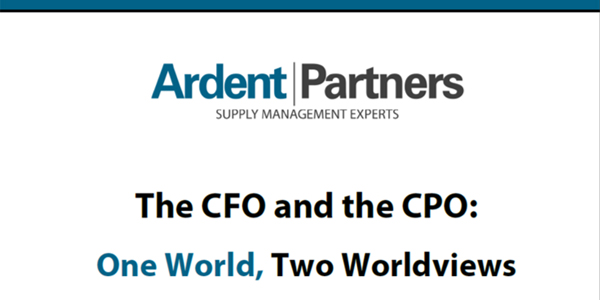Over the past few Thursdays, I have been highlighting the 15 annual CPO/State of Procurement reports that I have written. Near the end of Ardent Partners’ first year (2010), I tackled the CPO-CFO which was a decade ago, still a relationship that was fraught with tension and far from optimized. Most Chief Procurement Officers that I knew reported to the CFO absolutely hated it because the CFOs were almost solely focused on savings and not much else. This was an exciting report (the report published in January 2011) for me because it was the first big CPO report I wrote under the Ardent Partners banner and it was the first report that gave a big boost to our newsletter subscription list. JOIN HERE——>
As I have said about a few of the other reports after re-reading them, we have come a long, long way
In business, our experience and job role help form our perspectives. And, from these perspectives, most decisions are made. From any perspective, the relationship between the Chief Financial Officer (“CFO”) and the Chief Procurement Officer (“CPO”) remains one of the most difficult and challenging within business today; at the same time, it remains one of the most promising. This report looks at the opportunities and challenges facing these two C-Level leaders and their departments and makes a series of actionable recommendations that can help improve enterprise performance in the near-term and help build a foundation for a productive and thriving, long-term finance-procurement partnership.
The CFO: From CPA to CEO (in-Waiting) – Not so long ago, the path to becoming a Chief Financial Officer began with an undergraduate degree in accounting and the pursuit of a public accounting certification. After an early career in public accounting that culminated in a rise to the Manager or Senior Manager level, the accountant would move to a Controller or Assistant Controller position at a client organization. Once inside an enterprise, a very successful track record and an aggressive push was required to ascend to the role of CFO. On the finance and accounting career track, becoming a CFO was the ultimate, and often final, stop.
The CPO: From Novelty to Novel Performer – When business historians reflect on the first decade of the 21st Century, the broad-based transformation that occurred within the average enterprise’s procurement department will be on the list of the decade’s top trends and highlights. This is best evidenced by the emergence of the Chief Procurement Officer (sometimes called “Head of Procurement”) or CPO. The creation of this procurement leadership role with true C-level stature and C-level access has been a validation of the impact that procurement departments have had and can have on the enterprise. It is also a clear indication of the increasing importance now placed on the function.
“After three years of delivering significant results, I was recently named to the Executive Management Committee, reporting directly to our Finance Director [the “CFO”]. Unfortunately, he [the “CFO”] still has no interest or time to focus on the work we are doing, so I end up working around him.” – Chief Procurement Officer, Global Manufacturer (Europe)
The evolution and expansion of the CFO and CPO roles have served to bring these two leaders and their departments much closer together within the organization. Industry research shows that the CPO is more likely to report to the CFO than any other executive; as a result more and more newly opened CFO positions require at least an orientation towards procurement, if not an overarching competency in it.
The fact that many of the [procurement] strategies above deliver “non-ledger” benefits makes it very difficult for a finance department to recognize them without assistance. For example, the results from demand management strategies are almost invisible in the company financials and tools like automated spend analysis which can provide a detailed view of spend at the category and supplier level are needed to see the results of that strategy. This is not solely a CFO’s problem. It is incumbent upon finance and procurement to jointly pursue these strategies.
Readers of this report should understand that there are many CFOs that share their CPO’s worldview and proudly serve as procurement’s most powerful ally – helping it forge new paths, attempt new projects, and engage new stakeholders. These astute CFOs are now working in lock-step with their CPOs to drive greater value for the enterprise. Ardent expects that this number of CFOs will keep growing, since the CFO stands as a primary beneficiary of an empowered and effective procurement team. Unfortunately, the majority of CFOs still fail to recognize the true value add that procurement and its leader can deliver.
RELATED RESEARCH
Calling CFOs and CPOs: Ardent’s Procurement Metrics that Matter eBook is coming soon – Our June webinar will highlight the key findings in the report

